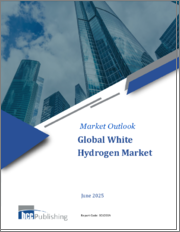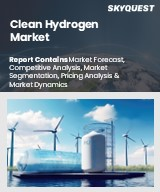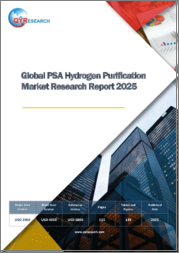
|
시장보고서
상품코드
1532568
수증기 메탄 개질 액화수소 시장 규모 : 유통, 최종 용도, 지역별 전망 및 예측, 2024-2032년Steam Methane Reforming Liquid Hydrogen Market Size - By Distribution (Pipelines, Cryogenic Tanks), By End Use (Transportation, Chemicals), Regional Outlook & Forecast, 2024 - 2032 |
||||||
수증기 메탄 개질 액체수소 세계 시장은 주요 기업의 기술 발전으로 2024-2032년 연평균 6.2%의 성장률을 나타낼 것으로 예상됩니다.
SMR은 천연가스를 활용하여 수소와 이산화탄소를 생성하는 수소 생산의 주요 방법입니다. 최근 발전은 이 공정의 효율성과 지속가능성을 강화하고 에너지 소비를 줄이며 탄소 배출을 최소화하는 데 초점을 맞추었습니다. 주요 기업은 개질 공정을 최적화하고 생산 비용을 낮추기 위해 첨단 촉매 및 열 통합 기술과 같은 혁신 기술에 투자하고 있습니다. 예를 들어 2023년 5월 프로테움 에너지(Proteum Energy)는 증기 비메탄 개질(Steam non-methane Reforming, SnMR)로 알려진 혁신적인 수소 생산 기술을 개발, 상표 등록 및 특허를 취득했습니다. 이 기술은 다양한 비메탄 및 산소화 탄화수소 원료를 개질하고 환경적 특성을 개선하여 수소 생산을 강화하는 기술입니다.
산업계가 에너지 저장 및 연료로 더 깨끗한 대안을 찾고 있는 가운데, 이러한 개선이 액체 수소에 대한 수요를 견인하고 있습니다. 또한 CO2 배출을 회수하고 활용하는 기술의 발전은 보다 광범위한 기후 변화 목표를 지원하고 저탄소 에너지 시스템으로의 전환을 위한 전 세계적인 노력과 일치합니다. 이러한 기술이 발전함에 따라 SMR 액체 수소 시장은 지속가능한 수소 솔루션에 대한 산업계와 환경의 관심이 높아짐에 따라 큰 폭의 성장을 보일 것으로 예상됩니다.
수증기 메탄 개질 액체 수소 시장은 극저온 탱크 분야에서 2024-2032년 연평균 성장률(CAGR)이 두드러지게 증가할 것으로 보입니다. 극저온 탱크는 액체 수소를 극저온에서 효율적으로 저장하고 운송하는 데 매우 중요합니다. 산업계가 에너지 및 산업 용도을 위해 수소 인프라를 확장함에 따라 신뢰할 수 있는 대용량 저장 솔루션에 대한 필요성이 증가하고 있습니다. 극저온 탱크 설계의 혁신은 저장 효율을 개선하고, 비용을 절감하며, 안전성을 향상시키고, 액체 수소의 보급을 촉진할 수 있습니다. 이러한 통합은 청정 에너지원으로서 수소의 확대를 지원하고 SMR에서 생산되는 액체 수소 시장 성장을 가속할 수 있습니다.
최종 용도별로는 화학 분야가 2024-2032년 두드러진 성장을 보일 것으로 예상됩니다. 수소는 비료용 암모니아 합성, 정유시 수소화 분해 등 다양한 화학 공정에서 중요한 역할을 하고 있습니다. 화학 분야가 생산 효율을 높이고 이산화탄소 배출량을 줄이려는 노력을 기울이고 있는 가운데, SMR에서 추출한 액체 수소는 보다 깨끗하고 효율적인 솔루션을 제공할 수 있습니다. 고순도 수소를 경제적으로 생산할 수 있는 능력은 업계가 보다 지속가능한 방식으로 전환하는 데 도움이 될 것입니다. 그 결과, 화학 용도에서 액체 수소의 사용 증가가 시장 성장을 주도하고 있으며, 이는 업계의 기술 혁신과 환경적 책임에 대한 노력을 반영하고 있습니다.
유럽의 수증기 메탄 개질 액체 수소 시장은 2024-2032년 상당한 CAGR을 보일 것으로 예상됩니다. 유럽 국가들은 탈탄소화 전략의 핵심 요소로 수소를 채택하고 있으며, 특히 산업 및 운송 분야에서 SMR은 효율성과 확장성으로 인해 여전히 수소 생산의 주요 수단으로 자리 잡고 있습니다. 유럽의 수소 인프라에 대한 투자는 지원 정책 및 인센티브와 함께 SMR로 생산된 액체 수소의 채택을 가속화하고 있습니다. 이러한 추세는 온실가스 감축과 친환경 에너지 경제로의 전환에 대한 유럽의 노력을 반영하고 있습니다.
목차
제1장 조사 방법과 조사 범위
제2장 개요
제3장 업계 인사이트
- 업계 에코시스템
- 규제 상황
- 업계에 대한 영향요인
- 촉진요인
- 업계의 잠재적 리스크&과제
- 성장 가능성 분석
- Porter의 산업 분석
- PESTEL 분석
제4장 경쟁 구도
- 서론
- 전략 대시보드
- 혁신과 테크놀러지 전망
제5장 시장 규모·예측 : 유통별, 2021-2032년
- 주요 동향
- 파이프라인
- 저온 탱크
제6장 시장 규모·예측 : 최종 용도별, 2021-2032년
- 주요 동향
- 운송
- 화학
- 기타
제7장 시장 규모·예측 : 지역별, 2021-2032년
- 주요 동향
- 북미
- 미국
- 캐나다
- 유럽
- 독일
- 영국
- 프랑스
- 이탈리아
- 아시아태평양
- 중국
- 인도
- 일본
- 한국
- 호주
- 세계의 기타 지역
제8장 기업 개요
- Air Liquide
- Air Products and Chemicals, Inc.
- Ballard Power Systems Inc
- Chart Industries
- ENGIE
- HyGear
- Iwatani Corporation
- Linde Plc
- Matheson Tri-Gas
- Praxair Technology, Inc.
- Reliance Industries
- Shell Plc
Global Steam Methane Reforming Liquid Hydrogen Market will witness 6.2% CAGR between 2024 and 2032 due to technological advances from leading companies. SMR remains a predominant method for producing hydrogen, leveraging natural gas to generate hydrogen and carbon dioxide. Recent advancements have focused on enhancing the efficiency and sustainability of this process, reducing energy consumption, and minimizing carbon emissions. Leading firms are investing in innovative technologies, such as advanced catalysts and heat integration techniques, to optimize the reforming process and lower production costs. For instance, in May 2023, Proteum Energy created, trademarked, and patented an innovative hydrogen production technology known as Steam non-methane Reforming (SnMR). This technology-enhanced hydrogen production by reforming and improving the environmental characteristics of various non-methane and oxygenated hydrocarbon feedstocks.
These improvements are driving the demand for liquid hydrogen as industries seek cleaner alternatives for energy storage and fuel. Additionally, technological progress in capturing and utilizing CO2 emissions supports broader climate goals, aligning with global efforts to transition to low-carbon energy systems. As these technologies evolve, the SMR liquid hydrogen market is poised for substantial growth, reflecting an increasing industrial and environmental focus on sustainable hydrogen solutions.
The overall Steam Methane Reforming Liquid Hydrogen Industry value is classified based on the distribution, end-use, and region.
Based on distribution, the steam methane reforming liquid hydrogen market revenue from the cryogenic tanks segment will register a commendable CAGR from 2024 to 2032. Cryogenic tanks are crucial for efficiently storing and transporting liquid hydrogen at extremely low temperatures. As industries seek to expand their hydrogen infrastructure for energy and industrial applications, the need for reliable, high-capacity storage solutions grows. Innovations in cryogenic tank design improve storage efficiency, reduce costs, and enhance safety, facilitating the wider adoption of liquid hydrogen. This integration supports the expansion of hydrogen as a clean energy source and drives market growth for SMR-produced liquid hydrogen.
In terms of end-use, the chemicals segment will witness an appreciable growth from 2024 to 2032. Hydrogen plays a critical role in various chemical processes, including ammonia synthesis for fertilizers and hydrocracking in petroleum refining. As the chemical sector seeks to enhance production efficiency and reduce carbon emissions, SMR-derived liquid hydrogen offers a cleaner and more efficient solution. The ability to produce high-purity hydrogen economically supports the industry's shift toward more sustainable practices. Consequently, the increased use of liquid hydrogen in chemical applications is driving market growth, reflecting the industry's commitment to innovation and environmental responsibility.
Europe steam methane reforming liquid hydrogen market will exhibit a notable CAGR from 2024 to 2032. European countries are increasingly adopting hydrogen as a key component in their decarbonization strategies, particularly for industrial applications and transportation. SMR remains a major method for producing hydrogen due to its efficiency and scalability. Europe's investments in hydrogen infrastructure, coupled with supportive policies and incentives, are accelerating the adoption of SMR-produced liquid hydrogen. This trend reflects Europe's commitment to reducing greenhouse gas emissions and transitioning to a greener energy economy.
Table of Contents
Chapter 1 Methodology & Scope
- 1.1 Research design
- 1.2 Base estimates & calculations
- 1.3 Forecast model
- 1.4 Primary research & validation
- 1.4.1 Primary sources
- 1.4.2 Data mining sources
- 1.5 Market definitions
Chapter 2 Executive Summary
- 2.1 Industry 360° synopsis, 2021 - 2032
Chapter 3 Industry Insights
- 3.1 Industry ecosystem
- 3.2 Regulatory landscape
- 3.3 Industry impact forces
- 3.3.1 Growth drivers
- 3.3.2 Industry pitfalls & challenges
- 3.4 Growth potential analysis
- 3.5 Porter's analysis
- 3.5.1 Bargaining power of suppliers
- 3.5.2 Bargaining power of buyers
- 3.5.3 Threat of new entrants
- 3.5.4 Threat of substitutes
- 3.6 PESTEL analysis
Chapter 4 Competitive landscape, 2023
- 4.1 Introduction
- 4.2 Strategic dashboard
- 4.3 Innovation & technology landscape
Chapter 5 Market Size and Forecast, By Distribution, 2021 - 2032 (USD Billion & MT)
- 5.1 Key trends
- 5.2 Pipelines
- 5.3 Cryogenic tanks
Chapter 6 Market Size and Forecast, By End Use, 2021 - 2032 (USD Billion & MT)
- 6.1 Key trends
- 6.2 Transportation
- 6.3 Chemicals
- 6.4 Others
Chapter 7 Market Size and Forecast, By Region, 2021 - 2032 (USD Billion & MT)
- 7.1 Key trends
- 7.2 North America
- 7.2.1 U.S.
- 7.2.2 Canada
- 7.3 Europe
- 7.3.1 Germany
- 7.3.2 UK
- 7.3.3 France
- 7.3.4 Italy
- 7.4 Asia Pacific
- 7.4.1 China
- 7.4.2 India
- 7.4.3 Japan
- 7.4.4 South Korea
- 7.4.5 Australia
- 7.5 Rest of World
Chapter 8 Company Profiles
- 8.1 Air Liquide
- 8.2 Air Products and Chemicals, Inc.
- 8.3 Ballard Power Systems Inc
- 8.4 Chart Industries
- 8.5 ENGIE
- 8.6 HyGear
- 8.7 Iwatani Corporation
- 8.8 Linde Plc
- 8.9 Matheson Tri-Gas
- 8.10 Praxair Technology, Inc.
- 8.11 Reliance Industries
- 8.12 Shell Plc



















